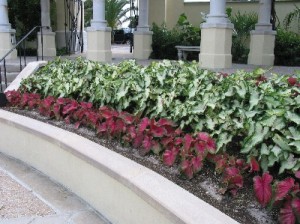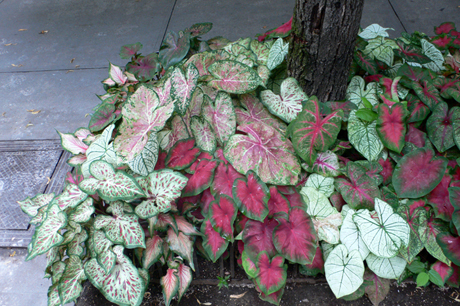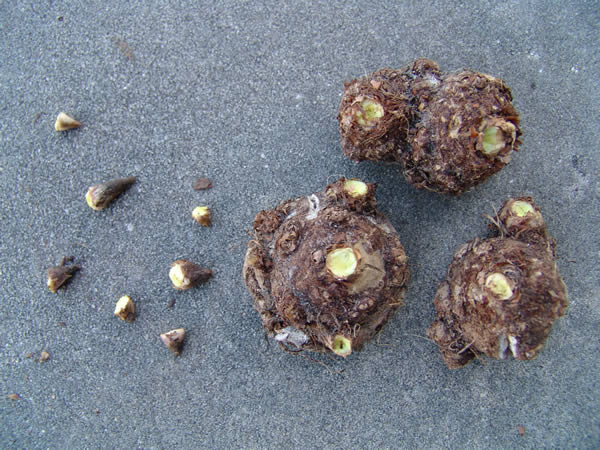Gardeners crave color in shady areas of their landscapes just as much as they do in sunny areas. Unfortunately, shade-loving plants generally are not so flamboyant, and the selection of colorful bedding plants for shady gardens is limited.
Thank goodness for caladiums. Even in fairly heavy shade they can be counted on to provide color through the summer.
Modern cultivars are primarily derived from caladium bicolor and its hybrids with other caladium species. They are grouped under the name Caladium x hortulanum. Caladiums belong to the arum family, which provides us with many tropical landscape plants and houseplants.
Caladiums are grown for their attractive foliage, which is produced from knobby brown tubers gardeners often call bulbs. The 6-inch to 12-inch, heart-shaped leaves emerge from the ground on arching stems that are generally 1 foot to 2 feet tall.
The foliage may be splashed with combinations of white, pink, rose, red, burgundy, chartreuse or green – often with several colors combined in wonderful patterns. These bright leaves, with their bold texture, embellish our shady gardens from May until October, when the tubers go dormant.
Caladiums also are remarkably free from major insect or disease problems and thrive in hot, humid weather.
They grow best in shade to part shade (two hours to four hours of direct sun, preferably morning sun). In those conditions they produce lush growth with large, colorful leaves.
Some cultivars are tolerant of more sunny conditions and are successful in beds receiving part to full sun (six hours or more of direct sun), but do avoid hot, dry, sunny locations.
Caladium plants you purchase at nurseries usually have been grown in shady greenhouses, so the foliage often will scorch or burn if you plant them into beds that receive too much direct sun. This results in brown areas and holes literally burned into the leaves. If the cultivar is sun-tolerant, new foliage eventually will emerge and adapt to the sunnier conditions, but I still think caladiums planted in full sun always seem to look stressed.
You can buy caladium tubers now and plant them directly into well-prepared beds. By now, some nurseries have caladium tubers on special sales at a good price, and since our growing season is so long, it is not too late to plant them.
Caladium plants also are available growing in 4-inch to 6-inch pots. They will provide immediate color in the landscape. Plant them about 8 inches to 12 inches apart, and they will grow larger and more beautiful through the summer.
Careful bed preparation will ensure healthy, robust plants. Turn the soil in the area to be planted and then incorporate a 2-inch to 4-inch layer of organic matter such as compost, rotted manure or peat moss. Next, lightly sprinkle the area with an all-purpose fertilizer, following the directions on its package, and rake it into the upper few inches of the soil. As an alternative, a little slow-release fertilizer can be placed around each tuber as it is planted into the bed.
Caladium plants should be planted with the top of the root ball level with the soil of the bed. Plant unsprouted tubers about 2 inches below the soil surface. When planting tubers, you should see growing points or even pinkish-white sprouts on the knobby side of the tuber. That side is planted up. The smoother, rounded side is the bottom of the tuber.
Once they are planted, mulch the bed with 2 inches of your favorite mulch and water in. Keep beds of caladiums well watered during the summer, especially those receiving lots of sun.
The colorful, tropical foliage of caladiums combines beautifully with impatiens, begonias, torenias, liriope, ferns, achimenes, gingers and other shade-loving plants. They generally are more effective when a single color or cultivar is used in a bed or an area of the landscape. If several colors are used, they are most effective when masses or groups of each color are combined in the planting.
In late September or October, cooler temperatures encourage caladiums to go dormant. When grown with poor growing conditions, particularly in areas of deep, heavy shade, the plants will likely produce small, weak tubers that may not return well, whether they are left in the ground or dug and stored. Under the right circumstances and with proper care, however, the tubers you planted this summer can be dug in the fall and planted next April or left in the ground to provide a beautiful display again next year – and for years to come.
All types of caladiums thrive here when they are planted in partly shaded locations. The cultivar you choose is a matter of your individual taste.
Keep in mind that if you are going to be planting caladiums in a sunny location, try these cultivars for better success: Candidum Junior, Carolyn Whorton, Fire Chief, Rosebud, White Queen, Jackie Suthers, Lance Whorton, Miss Muffet, Mumbo, Pink Gem, Red Frill, Sea Gull and Florida Sweetheart.



